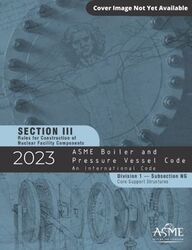
ASTM F519-10
Original price was: $65.00.$39.00Current price is: $39.00.
Standard Test Method for Mechanical Hydrogen Embrittlement Evaluation of Plating/Coating Processes and Service Environments
standard by ASTM International, 12/01/2010
1.1 This test method describes mechanical test methods and defines acceptance criteria for coating and plating processes that can cause hydrogen embrittlement in steels. Subsequent exposure to chemicals encountered in service environments, such as fluids, cleaning treatments or maintenance chemicals that come in contact with the plated/coated or bare surface of the steel, can also be evaluated.
1.2 This test method is not intended to measure the relative susceptibility of different steels. The relative susceptibility of different materials to hydrogen embrittlement may be determined in accordance with Test Method F1459 and Test Method F1624.
1.3 This test method specifies the use of air melted AISI E4340 steel per SAE AMS-S-5000 (formerly MIL-S-5000) heat treated to 260 – 280 ksi (pounds per square inch x 1000) as the baseline. This combination of alloy and heat treat level has been used for many years and a large database has been accumulated in the aerospace industry on its specific response to exposure to a wide variety of maintenance chemicals, or electroplated coatings, or both. Components with ultimate strengths higher than 260 – 280 ksi may not be represented by the baseline. In such cases, the cognizant engineering authority shall determine the need for manufacturing specimens from the specific material and heat treat condition of the component. Deviations from the baseline shall be reported as required by section 12.1.2. The sensitivity to hydrogen embrittlement shall be demonstrated for each lot of specimens as specified in section 9.5.
1.4 Test procedures and acceptance requirements are specified for seven specimens of different sizes, geometries, and loading configurations.
1.5 Pass/Fail Requirements – For plating/coating processes, specimens must meet or exceed 200 h using a sustained load test (SLT) at the levels shown in Table 3.
1.5.1 The loading conditions and pass/fail requirements for service environments are specified in Annex A5.
1.5.2 If approved by the cognizant engineering authority, a quantitative, accelerated (≤ 24 h) incremental step-load (ISL) test as defined in Annex A3 may be used as an alternative to SLT.
1.6 This test method is divided into two parts. The first part gives general information concerning requirements for hydrogen embrittlement testing. The second is composed of annexes that give specific requirements for the various loading and specimen configurations covered by this test method (see section 9.1 for a list of types) and the details for testing service environments.
1.7 The values stated in the foot-pound-second (fps) system in inch-pound units are to be regarded as standard. The values given in parentheses are mathematical conversions to SI units that are provided for information only and are not considered standard.
1.8 This standard does not purport to address all of the safety concerns, if any, associated with its use. It is the responsibility of the user of this standard to establish appropriate safety and health practices and determine the applicability of regulatory limitations prior to use.
Product Details
- Published:
- 12/01/2010
- Number of Pages:
- 18
- File Size:
- 1 file , 240 KB
- Redline File Size:
- 2 files , 410 KB
- Note:
- This product is unavailable in Russia, Ukraine, Belarus



